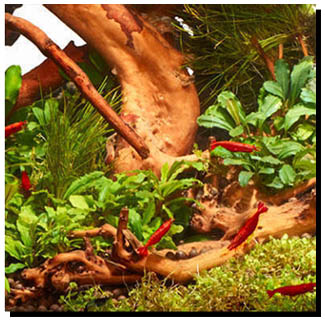Shrimp Tanks: The Latest Trend

Shrimp tanks are one of the newest trends in the aquarium hobby. Here is a quick overview of what you'll need to do to have successful shrimp tank.
(
Take a look at our new How To Set Up A Small Planted Shrimp Tank Video)
Characteristics of Shrimp Tanks
Shrimp tanks are aquariums that focus on small freshwater shrimp. These shrimp are small enough that they can usually fit on your thumbnail, and shrimp tanks are usually small (
under 10 gallons).
Shrimp aquariums are also often planted aquariums. Shrimp tend to do better in the natural environment that a planted aquarium provides. Many shrimp will eat algae that naturally grows on water plants, and they will also eat dead plant leaves or particulates that are often present in planted aquariums.
Shrimp tanks may or may not include fish. If they do, the fish should be very small because even medium sized fish will eat shrimp.
Picking a Tank
For shrimp smaller aquariums are often best as shrimp can get lost in large tanks. Among the most attractive options are
Lifegard Aquatics Crystal Aquariums. They’re small, high quality, and affordable. The
Lifegard Full View Aquariums are similar but have unique slanted fronts so you can look down at the shrimp more easily.
Filtration
Shrimp do not produce much waste, so any basic filter will work for shrimp. When choosing a filter, keep in mind that shrimp are small and can get sucked into many filters.
The built in filters in the Lifegard Aquatics Crystal Aquariums and Aqueon LED Shrimp Aquarium Kits are ideal for shrimp. With the Lifegard be sure to use the sponge just inside the intake to protect the shrimp.
With tanks without built-in filtration the
OASE BioCompact Internal Filters work well.
Temperature control
Freshwater shrimp do best at the same temperatures as tropical fish—between 76-80 degrees Fahrenheit. With warmer rooms the tank will stay within the acceptable range, but if your shrimp tank is in a colder room you will need need a heater. We like the
Cobalt Mini-Therm and Neo-Therm Heaters for small aquariums and shrimp tanks because they are the highest quality option in such a small size.
Water
Starting with good water is important for any aquarium. In shrimp aquariums tap water with a water conditioner such as
Aqueon Shrimp Tank Plus or
Seachem Prime is acceptable. But using RO water and adding a water conditioner such as
Brightwell Aquatics Shrimp Caridina GH+ or
Brightwell Aquatics Shrimp NeoTiger KH+/ GH+ is a better option. RO water will ensure any toxins like heavy metals are removed and the Caridina or NeoTiger will ensure the shrimp have the minerals they need for their exoskeleton. Adding
Brightwell Aquatics Shrimp Code two to three times a week will keep your shrimp healthy and enhance coloration.
Substrate
Because most shrimp tanks include live plants you need to make sure your substrate is an attractive environment for plants. Porous soil substrates are the best because they allow plant roots to access nutrients. Shrimp also tend to look better with a fine grain substrate in the background. The small grain size makes the shrimp appear larger. Our favorite choice of substrate is
Seachem Flourite Black Sand.
Decorations
Shrimp do best when they have places to hide. Live water plants and natural wood are great at providing natural hiding spaces. You can use natural decorations like
Lifegard Aquatics Serpentine Rock & Wood. As an alternative to natural décor there are many artificial decorations like the ones from
BiOrb.
Plants
Shrimp do not hurt plants and shrimp really like moss. Shrimp often hide in moss and they feed off of detritus and algae that can get caught in the moss. There are many kinds of moss to choose from, but one of the easiest mosses to grow is Java Moss. Java Moss does not require a significant amount of light or fertilizer to grow, making it easy for beginners. Mosses should be attached to hard surfaces such as rock or wood. To do this we like using
Flourish Plant Glue.
Shrimp also like moss balls and small stem plants such as Dwarf Sagittaria. Moss balls are made of algae and shrimp will slowly eat them. The balls are cheap enough they can be easily replaced and make for an interesting display piece. Small stem plants provide a great place for baby shrimp to hide while they are growing.
Feeding
Shrimp do not need a significant amount of food in an established aquarium. Much of the shrimp’s food comes from algae and detritus growing in the tank. Feeding your shrimp 2-3 times per week will suffice. Aqueon has an
Aqueon Herbivore Shrimp Food and an
Aqueon Omnivore Shrimp Food. We like natural food options such as
Sera Cattapa Leaves. If you have fish in the tank, the shrimp will likely be fine eating leftover fish food.
Maintenance
Maintaining a shrimp tank is similar to every other aquarium. However, because shrimp are natural scavengers and don’t produce much waste they are in some ways less intensive to care for than fish.
Here is a basic schedule for shrimp maintenance.
2 to 3 Times A Week
- Feed shrimp
- Add Shrimp Code
Every Week
- Top off the tank
- Clean the glass
At Least Once a Month
- Perform a water change of approximately 30%. Add water conditioner such as Caridina GH+ or Shrimp NeoTiger.
- Replace filter media
- Test Water
At Least Yearly
- Disassemble and clean the filter pump
- Clean the aquarium light and replace bulbs if applicable




























